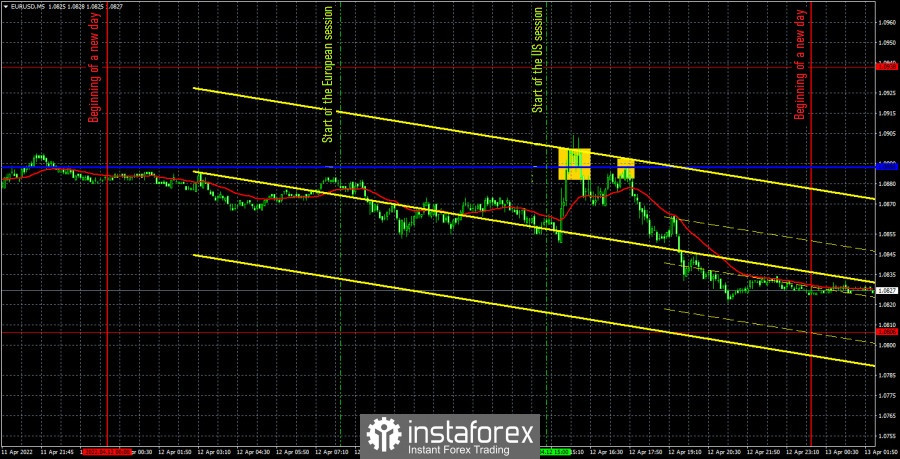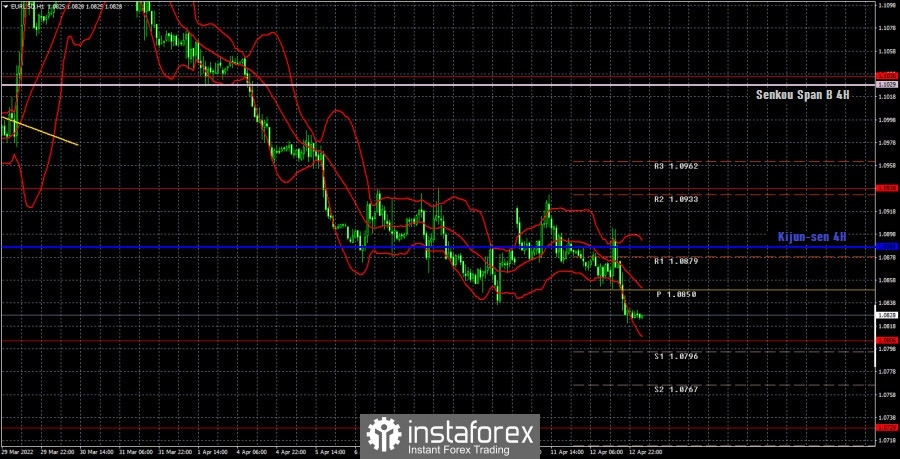EUR/USD 5M

The EUR/USD pair was trading in a bad way again on Tuesday. However, traders at least reacted to important macroeconomic statistics, which stirred up the pair a bit. We cannot conclude that the reaction to the US inflation report was absolutely logical. The chart clearly shows that at the very beginning of the US trading session, the pair began a sharp rise, which ended just above the critical line. It was at this time that the inflation report was released, and the US dollar, it turns out, fell in price after its release. Given that inflation continued to rise in March, we would say that the logical reaction would be a strengthening of the US currency, not a fall. However, the strengthening is exactly what happened to the dollar in the next few hours, as the pair turned down near the Kijun–sen line and showed an even stronger movement than the growth on the inflation report. As a result, the downward trend was maintained, and the bulls failed to settle above the Kijun-sen line.
There were few trading signals during the past day. Actually, only two. Both times the price bounced off the Kijun-sen line. The first time was absolutely inaccurate, but this signal should have been ignored anyway, since an inflation report was released 15-20 minutes before its formation, which was supposed to provoke a fall of the pair, not its growth. In general, it was not necessary to take risks. But the second rebound from the Kijun-sen line was much more accurate than the first and at that time the market had already calmed down, so it could be worked out. The pair managed to go down about 40 points, and that's how much traders could get yesterday on a single open trade deal.
COT report:

The latest Commitment of Traders (COT) report turned out to be more interesting than the previous ones. Even paradoxical, because the big players were building long positions. During the reporting week, the number of longs increased by 10,800, and the number of shorts in the "non-commercial" group - by 4,800. Thus, the net position increased by 6,000 contracts. This means that the bullish mood has intensified. It is bullish, since the total number of long positions now exceeds the total number of short positions with non-commercial traders by almost 30,000. Accordingly, the paradox lies in the fact that the mood of traders is bullish, but the euro is falling almost non-stop. We have already explained in previous articles that this effect is achieved by an even higher demand for the US dollar. It turns out that the demand for the dollar is higher than the demand for the euro, which is why the dollar is rising against the euro currency. Based on this conclusion, these COT reports on the euro currency now do not make it possible to predict the pair's further movement. They are, one might say, meaningless. However, if the demand for the euro starts to fall among professional players, this may lead to an even greater fall in the euro, since the demand for the dollar is likely to remain high due to geopolitics and macroeconomics.
We recommend to familiarize yourself with:
Overview of the EUR/USD pair. April 13. US inflation continues to grow by leaps and bounds.
Overview of the GBP/USD pair. April 13. Chip and Dale rush to the rescue: Finland and Sweden are preparing to join NATO.
Forecast and trading signals for GBP/USD on April 13. Detailed analysis of the movement of the pair and trading transactions.
EUR/USD 1H

On the hourly timeframe, it is clearly visible that the pair continues its downward movement and maintains a downward trend, which is not supported by either a trend line or a channel: they are still impossible to form. However, yesterday once again showed the strength of the bulls, who were not even able to overcome the critical line. What kind of correction can we talk about now? Plus, the macroeconomic and fundamental backgrounds remain in favor of the dollar. The rise in US inflation further increases the likelihood of an aggressive tightening of the Federal Reserve's monetary policy in the coming months. We allocate the following levels for trading on Wednesday – 1.0729, 1.0806, 1.0938, 1.1036, as well as the Senkou Span B (1.1029) and Kijun-sen (1.0888) lines. The lines of the Ichimoku indicator can move during the day, which should be taken into account when determining trading signals. There are also support and resistance levels, but no signals will be formed near them. Signals can be "bounces" and "breakthrough" levels- extremes and lines. Do not forget about placing a Stop Loss order at breakeven if the price went in the right direction of 15 points. This will protect you against possible losses if the signal turns out to be false. There are no important or even interesting events or reports scheduled for April 13 in the European Union and the United States. The producer price index can hardly be considered important. Thus, today traders will be able to react only to non-geopolitical news. If they will.
Explanations for the chart:
Support and Resistance Levels are the levels that serve as targets when buying or selling the pair. You can place Take Profit near these levels.
Kijun-sen and Senkou Span B lines are lines of the Ichimoku indicator transferred to the hourly timeframe from the 4-hour one.
Support and resistance areas are areas from which the price has repeatedly rebounded off.
Yellow lines are trend lines, trend channels and any other technical patterns.
Indicator 1 on the COT charts is the size of the net position of each category of traders.















